Srivijaya
| Srivijaya Kadatuan Sriwijaya | |||||||||||||||
|---|---|---|---|---|---|---|---|---|---|---|---|---|---|---|---|
| 650–1377 | |||||||||||||||
 The maximum extent of Srivijaya around 8th century with series of Srivijayan expeditions and conquest | |||||||||||||||
| Status | Vassal of the Melayu Kingdom (1183–1377) | ||||||||||||||
| Capital | |||||||||||||||
| Common languages | Old Malay, Sanskrit | ||||||||||||||
| Religion | Vajrayana Buddhism, Animism and Hinduism | ||||||||||||||
| Government | Monarchy | ||||||||||||||
| Maharaja | |||||||||||||||
• Circa 683 | Dapunta Hyang Sri Jayanasa | ||||||||||||||
• Circa 775 | Dharmasetu | ||||||||||||||
• Circa 792 | Samaratungga | ||||||||||||||
• Circa 835 | Balaputra | ||||||||||||||
• Circa 988 | Sri Cudamani Warmadewa | ||||||||||||||
| History | |||||||||||||||
• Dapunta Hyang's expedition and expansion, (Kedukan Bukit inscription) | 650 | ||||||||||||||
| 1377 | |||||||||||||||
| Currency | Native gold and silver coins | ||||||||||||||
| |||||||||||||||
Srivijaya (also written Sri Vijaya, Indonesian/Malay: Sriwijaya, Javanese: ꦯꦿꦶꦮꦶꦗꦪ, Sundanese: ᮞᮢᮤᮝᮤᮏᮚ, Thai: ศรีวิชัย RTGS: Siwichai, Sanskrit: श्रीविजय, Śrīvijaya, Khmer: ស្រីវិជ័យ Srey Vichey, Chinese: 三佛齊 Sanfoqi)[1]:131 was a dominant thalassocratic Indonesian city-state based on the island of Sumatra, Indonesia, which influenced much of Southeast Asia.[2] Srivijaya was an important centre for the expansion of Buddhism from the 8th to the 12th century. Srivijaya was the first unified kingdom to dominate much of Malay archipelago.[3] The rise of the Srivijayan Empire is seen to run parallel to the end of the Malay sea-faring period. Due to its location, this once powerful state developed complex technology utilizing maritime resources. In addition, its economy became progressively reliant on the booming trade in the region, thus transforming it into a prestige goods based economy.[4]
The earliest reference to it dates from the 7th century. A Tang Chinese monk, Yijing, wrote that he visited Srivijaya in 671 for six months.[5][6] The earliest known inscription in which the name Srivijaya appears also dates from the 7th century in the Kedukan Bukit inscription found near Palembang, Sumatra, dated 16 June 682.[7] Between the late 7th and early 11th century, Srivijaya rose to become a hegemon in Southeast Asia. It was involved in close interactions, often rivalries, with the neighbouring Java, Kambuja and Champa. Srivijaya's main foreign interest was nurturing lucrative trade agreements with China which lasted from the Tang to the Song dynasty. Srivijaya had religious, cultural and trade links with the Buddhist Pala of Bengal, as well as with the Islamic Caliphate in the Middle East.
The kingdom ceased to exist in the 13th century due to various factors, including the expansion of the rival Javanese Singhasari and Majapahit empires.[2] After Srivijaya fell, it was largely forgotten. It was not until 1918 that French historian George Cœdès, of École française d'Extrême-Orient, formally postulated its existence.[8]
Etymology
In Sanskrit, śrī[9] means "fortunate", "prosperous", or "happy" and vijaya[10] means "victorious" or "excellence".[8] Thus the combined word Srivijaya means "shining victory",[11] "splendid triumph", "prosperous victor", "radiance of excellence" or simply "glorious".
Initially, historians of early 20th-century that studied the inscriptions of Sumatra and the neighboring islands, thought that the term "Srivijaya" refer to a person's name — a king to be exact. The Sundanese manuscript of Carita Parahyangan composed around the late 16th-century in West Java, mentioned vaguely about a princely hero that rose to be a king named Sanjaya that after secured his rule in Java — involved in battle with the Malayu and Keling, against their king named "Sang Srivijaya". The term Malayu is Javanese-Sundanese term to refer Malay people of Sumatra, while Keling — derived from historical Kalinga kingdom of Southern India, refer to people of Indian descent that inhabit the archipelago. Fascinatingly, the name Srivijaya still being found in this local manuscript, although was mistakenly refer to a king. Subsequently, after studying both local stone inscriptions, manuscripts and Chinese historical accounts, historians concluded that the term "Srivijaya" refer to a polity or a kingdom.
Historiography
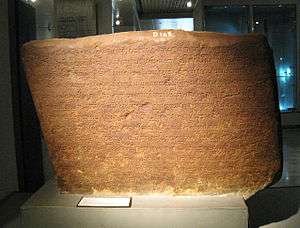
Little physical evidence of Srivijaya remains.[12] There had been no continuous knowledge of the history of Srivijaya even in Indonesia and Malaysia; its forgotten past has been resurrected by foreign scholars. Contemporary Indonesians, even those from the area of Palembang (around which the kingdom was based), had not heard of Srivijaya until the 1920s when the French scholar, George Cœdès, published his discoveries and interpretations in the Dutch- and Indonesian-language newspapers.[13] Cœdès noted that the Chinese references to "Sanfoqi", previously read as "Sribhoja", and the inscriptions in Old Malay refer to the same empire.[14]
The Srivijayan historiography was acquired, composed and established from two main sources: the Chinese historical accounts and the Southeast Asian stone inscriptions that have been discovered and deciphered in the region. The Buddhist pilgrim Yijing's account is especially important on describing Srivijaya, when he visited the kingdom in 671 for six months. The 7th-century siddhayatra inscriptions discovered in Palembang and Bangka island are also vital primary historical sources. Also, regional accounts that some might be almost tales and legends, such as the Legend of the Maharaja of Javaka and the Khmer King also provides a glimpse of the kingdom. Besides, some Indian and Arabic accounts also describes vaguely about the riches and fabulous fortune of the king of Zabag.
The historical records of Srivijaya were reconstructed from a number of stone inscriptions, most of them written in Old Malay using Pallava script, such as the Kedukan Bukit, Talang Tuwo, Telaga Batu and Kota Kapur inscriptions.[1]:82–83 Srivijaya had become a symbol of early Sumatran importance as a great empire to balance Java's Majapahit in the east. In the 20th century, both empires were referred to by nationalistic intellectuals to argue for an Indonesian identity within an Indonesian state that had existed prior to the colonial state of the Dutch East Indies.[13]
Srivijaya, and by extension Sumatra, had been known by different names to different peoples. The Chinese called it Sanfoqi or Che-li-fo-che (Shilifoshi), and there was an even older kingdom of Kantoli, which could be considered the predecessor of Srivijaya.[15][16] Sanskrit and Pali texts referred to it as Yavades and Javadeh, respectively.[15] The Arabs called it Zabag or Sribuza and the Khmers called it Melayu.[15] While the Javanese called them Suvarnabhumi, Suvarnadvipa or Malayu. This is another reason why the discovery of Srivijaya was so difficult.[15] While some of these names are strongly reminiscent of the name of "Java", there is a distinct possibility that they may have referred to Sumatra instead.[17]
Capital
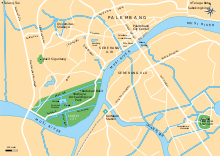
According to the Kedukan Bukit inscription, dated 605 Saka (683), Srivijaya was first established in the vicinity of today's Palembang, on the banks of Musi River. It mentions that Dapunta Hyang Sri Jayanasa came from Minanga Tamwan. The exact location of Minanga Tamwan is still a subject of discussion. The Palembang theory as the place where Srivijaya was first established was presented by Cœdes and supported by Pierre-Yves Manguin. Soekmono, on the other hand, argues that Palembang was not the capital of Srivijaya and suggests that the Kampar River system in Riau where the Muara Takus temple is located as Minanga Tamwan.[18]
Palembang left little archaeological traces of ancient urban settlement. This is probably because of the nature of Palembang environment — a low lying plain which frequently flooded by Musi River. Expert suggests that the ancient Palembang settlement was formed as a collection of floating houses made from thatched materials, such as wood, bamboo and straw roof. The 13th century Chinese account confirmed this; in his book Chu-Fan-Chi, Chau-Ju-kua mentioned that "The residents Sanfo-tsi (Srivijaya) live scattered outside the city on the water, within rafts lined with reeds." It was probably only Kadatuan (king's court) and religious structures were built on land, while the people live in floating houses along Musi River.[19]
Palembang and its relevance to the early Malay state suffered a great deal of controversy in terms of its evidence build up through the archaeological record. Strong historical evidence found in Chinese sources, speaking of city like settlements as early as 700 AD, and later Arab travelers, who visited the region during the 10th and 11th centuries, held written proof, naming the kingdom of Srivijaya in their context. As far as early state-like polities in Malay archipelago, the geographical location of modern Palembang was a possible candidate for the 1st millennium kingdom settlement like Srivijaya as it is the best described and most secure in historical context, its prestige was apparent in wealth and in urban characteristics, and the most unique, which no other 1st millennium kingdom held, was its location in junction to three major rivers, the Musi, the Komering, and the Ogan. The historical evidence was contrasted in 1975 with publications by Bennet Bronson and Jan Wisseman. Findings at certain major excavation sites, such as Geding Suro, Penyaringan Air Bersih, Sarang Wati, and Bukit Seguntang, conducted in the region played major roles in the negative evidence of the 1st millennium kingdom in the same region. It was noted that the region contained no locatable settlements earlier than the middle of the second millennium.
Lack of evidence of southern settlements in the archaeological record come from the disinterest in the archeologist and the unclear physical visibility of the settlement themselves. Archeology of the 1920s and 1930s focused more on art and epigraphy found in the regions. Some northern urban settlements were sited due to some overlap in fitting the sinocentic model of city-state urban centers. An approach to differentualize between urban settlements in the southern regions from the northern ones of Southeast Asia was initiated by a proposition for an alternative model. Excavations showed failed signs of a complex urban center under the lens of a sinocentric model, leading to parameters of a new proposed model. Parameters for such a model of a city-like settlement included isolation in relevance to its hinterland. No hinterland creates for low archaeological visibility. The settlement must also have access to both easy transportation and major interregional trade routes, crucial in a region with few resources. Access to the former and later play a major role in a creation of extreme economic surplus in the absence of an exploited hinterland. The urban center must be able to organize politically without the need of ceremonial foci such as temples, monuments and inscriptions. Lastly, habitations must be impermanent, being highly probable in the region Palembang and of southern Southeast Asia. Such a model was proposed to challenge city concepts of ancient urban centers in Southeast Asia and basic postulates themselves such as regions found in the South, like Palembang, based their achievements in correlation with urbanization.[20]
Due to the contradicting pattern found in southern regions, like Palembang, in 1977 Bennet Bronson developed a speculative model for a better understanding of the Sumatran coastal region, such as insular and peninsular Malaysia, the Philippines, and western Indonesia. Its main focus being the relationship of political, economical and geographical systems. The general political and economical pattern of the region seems irrelevant to other parts of the world of their time, but in correlation with their maritime trade network it produced high levels of socio-economic complexity. He concluded, from his earlier publications in 1974 that state development in this region developed much differently than the rest of early Southeast Asia. Bronson’s model was based on the dendritic patterns of a drainage basin where its opening leads out to sea. Being that historical evidence places the capital in Palembang, and in junction of three rivers, the Musi, the Komering, and the Ogan, such model can be applied. In order for the system to function appropriately several constraints are required. Inability for terrestrial transportation results in movements of all good through water routes, lining up economical patterns with the dendritic patterns formed by the streams. The second being the overseas center is economically superior to the ports found at the mouth of the rivers, having a higher population and a more productive and technologically advanced economy. Lastly, constraints on the land work against and do not developments of urban settlements.[21]

An aerial photograph taken in 1984 near Palembang (in what is now Sriwijaya Kingdom Archaeological Park) revealed the remnants of ancient man-made canals, moats, ponds, and artificial islands, suggesting the location of Srivijaya's urban centre. Several artefacts such as fragments of inscriptions, Buddhist statues, beads, pottery and Chinese ceramics were found, confirming that the area had, at one time, dense human habitation.[22] By 1993, Pierre-Yves Manguin had shown that the centre of Srivijaya was along the Musi River between Bukit Seguntang and Sabokingking (situated in what is now Palembang, South Sumatra, Indonesia).[8] Palembang is called in Chinese: 巨港; pinyin: Jù gǎng; literally: "Giant Harbour", this is probably a testament of its history as once a great port.
However, in 2013, archaeological research led by the University of Indonesia discovered several religious and habitation sites at Muaro Jambi, suggesting that the initial centre of Srivijaya was located in Muaro Jambi Regency, Jambi on the Batang Hari River, rather than on the originally-proposed Musi river.[23] The archaeological site includes eight excavated temple sanctuaries and covers about 12 square kilometers, stretches 7.5 kilometers along the Batang Hari River, 80 menapos or mounds of temple ruins, are not yet restored.[24][25] The Muaro Jambi archaeological site was Mahayana-Vajrayana Buddhist in nature, which suggests that the site served as the Buddhist learning center, connected to the 10th century famous Buddhist scholar Suvarṇadvipi Dharmakīrti. Chinese sources also mentioned that Srivijaya hosts thousands of Buddhist monks.
Another theory suggests that Dapunta Hyang came from the east coast of the Malay Peninsula, and that the Chaiya District in Surat Thani Province, Thailand, was the centre of Srivijaya.[26] The Srivijayan Period is referred to the time when Srivijaya ruled over present day southern Thailand. In the region of Chaiya, there is clear evidence of Srivijayan influence seen in artwork inspired by Mahayana Buddhism. Because of the large amount of remains, such as the Ligor stele, found in this region, some scholars attempted to prove Chaiya as the capital rather than Palembang.[27] This period was also a time for art. The Buddhist art of the Srivijayan Kingdom was believed to have borrow from Indian styles like that of the Dvaravati school of art.[28] The city of Chaiya's name may be derived from the Malay name "Cahaya" which means "light" or "radiance". However, some scholars believe that Chaiya probably comes from Sri Vijaya. It was a regional capital in the Srivijaya empire. Some Thai historians argue it was the capital of Srivijaya itself,[29] but this is generally discounted.
.jpg)
In the second half of the eighth century, the capital of Srivijayan Mandala seems to be relocated and reestablished in Central Java, in the splendid court of Medang Mataram located somewhere in fertile Kedu and Kewu Plain, in the same location of the majestic Borobudur, Manjusrigrha and Prambanan monuments. This unique period is known as the Srivijayan episode in Central Java, when the monarch of Sailendras rose to become the Maharaja of Srivijaya. By that time, Srivijayan Mandala seems to be consists of the federation or an alliance of city-states, spanned from Java to Sumatra and Malay Peninsula, connected with trade connection cemented with political allegiance. By that time Srivijayan trading centers remains in Palembang, and to further extent also includes ports of Jambi, Kedah and Chaiya; while its political, religious and ceremonial center was established in Central Java.
History
Formation and growth
Siddhayatra
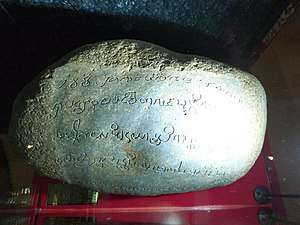
Around the year 500, the roots of the Srivijayan empire began to develop around present-day Palembang, Sumatra. The Kedukan Bukit inscription (683), discovered on the banks of the Tatang River, near Karanganyar site, mentioned that the empire of Srivijaya was founded by Dapunta Hyang Sri Jayanasa and his retinue. He had embarked on a sacred siddhayatra[30] journey, and led 20,000 troops and 312 people in boats with 1312 foot soldiers from Minanga Tamwan to Jambi and Palembang.
From the Sanskrit inscriptions, it is notable that Dapunta Hyang Sri Jayanasa launched a maritime conquest in 684 with 20,000 men in the siddhayatra journey to acquire wealth, power, and 'magical powers'.[31] Under the leadership of Dapunta Hyang Sri Jayanasa, the Melayu Kingdom became the first kingdom to be integrated into Srivijaya. This possibly occurred in the 680s. Melayu, also known as Jambi, was rich in gold and held in high esteem at the time. Srivijaya recognised that the submission of Melayu would increase its own prestige.[32]
The empire was organised in three main zones: the estuarine capital region centred on Palembang, the Musi River basin which served as hinterland, and rival estuarine areas capable of forming rival power centres. The areas upstream of the Musi River were rich in various commodities valuable to Chinese traders.[33] The capital was administered directly by the ruler while the hinterland remained under its own local datus or tribal chiefs, who were organised into a network of alliances with the Srivijaya maharaja or king. Force was the dominant element in the empire's relations with rival river systems such as the Batang Hari River, centred in Jambi.
The Telaga Batu inscription, discovered in Sabokingking, eastern Palembang, is also a siddhayatra inscription. It is highly possible that this 7th century inscription was used in some kind of oath allegiance ritual. The top of the stone is adorned with seven nāga heads, and on the lower portion, there is some kind of water spout to channel the liquid that was likely poured over the stone during a ceremonial allegiance ritual. The ritual demonstrate the use of curse in sumpah (allegiance) ritual for those who commit treason against Kadatuan Srivijaya.
The Talang Tuwo inscription, is also a siddhayatra inscription. Discovered in Bukit Seguntang, western Palembang, this inscription tells about the establishment of the bountiful Śrīksetra garden endowed by King Jayanasa of Srivijaya, for the well being of all creatures.[1]:82–83 It is highly possible that the currently Bukit Seguntang site was the location of Srivijaya's Śrīksetra garden.
Regional conquests
According to the Kota Kapur inscription discovered on Bangka Island, the empire conquered most of southern Sumatra and the neighbouring island of Bangka, as far as Palas Pasemah in Lampung. Also, according to the inscriptions, Dapunta Hyang Sri Jayanasa launched a military campaign against Java in the late 7th century, a period which coincided with the decline of Tarumanagara in West Java and the Kalingga in Central Java. The empire thus grew to control the trade on the Strait of Malacca, the Sunda Strait, the South China Sea, the Java Sea, and the Karimata Strait.
Chinese records dating to the late 7th century mention two Sumatran kingdoms as well as three other kingdoms on Java as being part of Srivijaya. By the end of the 8th century, many western Javanese kingdoms, such as Tarumanagara and Kalingga, were within the Srivijayan sphere of influence.
Golden age
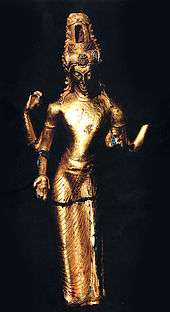
The 7th century Sojomerto inscription mentioned that an Old Malay-speaking Shivaist family led by Dapunta Selendra, has established themselves in Batang area, northern coast of Central Java. He was possibly the progenitor of Sailendra family. By early 8th century, an influential Buddhist family related to Srivijaya dominated Central Java.[34] The family was the Sailendras.[35] The Sailendras were of Javanese origin.[36] The ruling lineage of Srivijaya intermarried with the Sailendras of Central Java.
Conquest of Malay Peninsula
Part of a series on the |
||||||||||||||||||||||||||||||||||||||||||||||||||||||||||||||||||||||||||||||||||
|---|---|---|---|---|---|---|---|---|---|---|---|---|---|---|---|---|---|---|---|---|---|---|---|---|---|---|---|---|---|---|---|---|---|---|---|---|---|---|---|---|---|---|---|---|---|---|---|---|---|---|---|---|---|---|---|---|---|---|---|---|---|---|---|---|---|---|---|---|---|---|---|---|---|---|---|---|---|---|---|---|---|---|
| History of Malaysia | ||||||||||||||||||||||||||||||||||||||||||||||||||||||||||||||||||||||||||||||||||
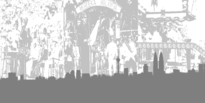 | ||||||||||||||||||||||||||||||||||||||||||||||||||||||||||||||||||||||||||||||||||
|
Prehistoric Malaysia
|
||||||||||||||||||||||||||||||||||||||||||||||||||||||||||||||||||||||||||||||||||
|
Early kingdoms
|
||||||||||||||||||||||||||||||||||||||||||||||||||||||||||||||||||||||||||||||||||
|
Rise of Muslim states
|
||||||||||||||||||||||||||||||||||||||||||||||||||||||||||||||||||||||||||||||||||
|
Colonial era
|
||||||||||||||||||||||||||||||||||||||||||||||||||||||||||||||||||||||||||||||||||
|
World War II
|
||||||||||||||||||||||||||||||||||||||||||||||||||||||||||||||||||||||||||||||||||
|
Formation of Malaysia
|
||||||||||||||||||||||||||||||||||||||||||||||||||||||||||||||||||||||||||||||||||
|
Incidents
|
||||||||||||||||||||||||||||||||||||||||||||||||||||||||||||||||||||||||||||||||||
|
By topic |
||||||||||||||||||||||||||||||||||||||||||||||||||||||||||||||||||||||||||||||||||
|
| ||||||||||||||||||||||||||||||||||||||||||||||||||||||||||||||||||||||||||||||||||

During the same century, Langkasuka on the Malay Peninsula became part of Srivijaya.[37] Soon after this, Pan Pan and Tambralinga, which were located north of Langkasuka, came under Srivijayan influence. These kingdoms on the peninsula were major trading nations that transported goods across the peninsula's isthmus.
The Ligor inscription in Vat Sema Muang, mentioned that Maharaja of Srivijaya, Dharmasetu ordered the construction of three sanctuaries dedicated to Bodhisattvas Padmapani, Vajrapani and Buddha located in Southern Thailand Malay Peninsula.[38] The inscription further stated that the Dharmasetu was the head of the Sailendras of Java. This is the first instance of relationship known existed between Srivijaya and the Sailendra. With the expansion into Java and the Malay Peninsula, Srivijaya controlled two major trade choke points in Southeast Asia; Malacca and Sunda straits. Some Srivijayan temple ruins are observable in Thailand and Cambodia.
At some point in the late 7th century, Cham ports in eastern Indochina started to attract traders. This diverted the flow of trade from Srivijaya. In an effort to divert the flow, the Srivijayan Maharaja Dharmasetu, launched various raids against the coastal cities of Indochina. The city of Indrapura by the Mekong was temporarily controlled from Palembang in the early 8th century.[35] The Srivijayans continued to dominate areas around present-day Cambodia until the Khmer King Jayavarman II, the founder of the Khmer Empire dynasty, severed the Srivijayan link later in the same century.[39]
Srivijayan rule in Central Java
The Sailendras of Java established and nurtured a dynastic alliance with the Sumatran Srivijayan lineage, and then further established their rule and authority in Medang Mataram Kingdom of Central Java.
In Java, Dharanindra's successor was Samaragrawira (r. 800—819), mentioned in Nalanda inscription (dated 860) as the father of Balaputradewa, and the son of Śailendravamsatilaka (the jewel of the Śailendra family) with stylised name Śrīviravairimathana (the slayer of a heroic enemy), which refers to Dharanindra.[40]:92 Unlike his predecessor, the expansive and warlike Dharanindra, Samaragrawira seems to have been a pacifist, enjoying a peaceful prosperity of interior Java in Kedu Plain and being more interested on completing the Borobudur project. He appointed Khmer Prince Jayavarman as the governor of Indrapura in the Mekong delta under Sailendran rule. This decision was later proven to be a mistake, as Jayavarman later revolted, moved his capital further inland north from Tonle Sap to Mahendraparvata, severed the link to Srivijaya and proclaimed Cambodian independence from Java in 802. Samaragrawira was mentioned as the king of Java that married Tārā, daughter of Dharmasetu.[40]:108 He was mentioned as his other name Rakai Warak in Mantyasih inscription.
Earlier historians, such as N. J. Krom and Cœdes, tend to equate Samaragrawira and Samaratungga as the same person.[40]:92 However, later historians such as Slamet Muljana equate Samaratungga with Rakai Garung, mentioned in Mantyasih inscription as fifth monarch of Mataram kingdom. This would mean that Samaratungga was the successor of Samaragrawira.
Dewi Tara, the daughter of Dharmasetu, married Samaratunga, a member of the Sailendra family who later assumed throne of Srivijaya, around 792.[41] By 8th century, the Srivijayan court was virtually located in Java, as the Sailendras monarch rose to become the Maharaja of Srivijaya.
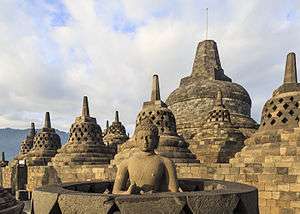
After Dharmasetu, Samaratungga became the next Maharaja of Srivijaya. He reigned as ruler from 792 to 835. Unlike the expansionist Dharmasetu, Samaratungga did not indulge in military expansion but preferred to strengthen the Srivijayan hold of Java. He personally oversaw the construction of the grand monument of Borobudur; a massive stone mandala, which was completed in 825, during his reign.[42] According to Cœdès, "in the second half of the ninth century Java and Sumatra were united under the rule of a Sailendra reigning in Java... its center at Palembang."[1]:92 Samaratungga just like Samaragrawira, seems to be deeply influenced by peaceful Mahayana Buddhist beliefs and strived to become a peaceful and a benevolent ruler. His successor was Princess Pramodhawardhani who was betrothed to Shivaite Rakai Pikatan, son of the influential Rakai Patapan, a landlord in Central Java. The political move that seems as an effort to secure peace and Sailendran rule on Java by reconciling the Mahayana Buddhist with Shivaist Hindus.
Return to Palembang
Prince Balaputra, however, opposed the rule of Pikatan and Pramodhawardhani in Central Java. The relations between Balaputra and Pramodhawardhani is interpreted differently by some historians. Older theory according to Bosch and De Casparis holds that Balaputra was the son of Samaratungga, which means he was the younger brother of Pramodhawardhani. Later historians such as Muljana on the other hand, argued that Balaputra was the son of Samaragrawira and the younger brother of Samaratungga, which means he was the uncle of Pramodhawardhani.[43]
It is not known whether Balaputra was expelled from Central Java because of succession dispute with Pikatan, or was he already ruled in Suvarnadvipa (Sumatra). Either ways, it seems that Balaputra eventually ruled the Sumatran branch of Sailendra dynasty and enthroned in Srivijayan capital of Palembang. Historians argued that this was because Balaputra's mother — Tara, the queen consort of King Samaragrawira was the princess of Srivijaya, this rendered Balaputra as the heir of Srivijayan throne. Balaputra the Maharaja of Srivijaya later stated his claim as the rightful heir of Sailendra dynasty from Java, as proclaimed in Nalanda inscription dated 860.[40]:108
After trade disruption at Canton between 820 and 850, the ruler of Jambi (Melayu Kingdom) was able to assert enough independence to send missions to China in 853 and 871. The Melayu kingdom's independence coincided with the troubled times when the Sailendran Balaputradewa, was expelled from Java and, later, he seized the throne of Srivijaya. The new maharaja was able to dispatch a tributary mission to China by 902. Two years after that, the expiring Tang Dynasty conferred a title on a Srivijayan envoy.
In the first half of the 10th century, between the fall of Tang Dynasty and the rise of Song, there was brisk trading between the overseas world with the Fujian kingdom of Min and the rich Guangdong kingdom of Nan Han. Srivijaya undoubtedly benefited from this. Sometime around 903, the Muslim writer Ibn Rustah was so impressed with the wealth of the Srivijayan ruler that he declared that one would not hear of a king who was richer, stronger or who had more revenue. The main urban centres of Srivijaya were then at Palembang (especially the Karanganyar site near Bukit Seguntang area), Muara Jambi and Kedah.
Srivijayan exploration
The core of the Srivijayan realm was mainly concentrated in and around the straits of Malacca and Sunda; in Sumatra, the Malay Peninsula and Western Java. However, between the 9th and the 12th centuries, the influence of Srivijaya seems to be extended far beyond their core realm. Srivijayan navigators, sailors and traders seems to be engaged in extensive trade and exploration, which reached coastal Borneo, the Philippines archipelago, Eastern Indonesia, coastal Indochina, Bay of Bengal and Indian Ocean, as far as Madagascar.[44]
The migration to Madagascar accelerated in the 9th century when Srivijaya controlled much of the maritime trade in the Indian Ocean.[45] The migration to Madagascar was estimated to have taken place 1,200 years ago around 830 CE. According to an extensive new mitochondrial DNA study, native Malagasy people today can likely trace their heritage back to the 30 founding mothers who sailed from Indonesia 1,200 years ago.[46] Malagasy contains loan words from Sanskrit, with all the local linguistic modifications via Javanese or Malay, hint that Madagascar may have been colonised by settlers from the Srivijaya.[47] At that time, Srivijaya was expanding its maritime trade network.[48]
The influence of the empire reached Manila by the 10th century. A kingdom under its sphere of influence had already been established there.[49][50] The discovery of golden Tara statue in Agusan del Sur, also golden Kinnara from Butuan, Northeastern Mindanao, in the Philippines suggests the ancient link between ancient Philippines and the Srivijayan empire.[51] Tara and Kinnara are important figures or deities in Mahayana Buddhist beliefs. The Mahayana-Vajrayana Buddhist religious commonality is interesting, it is possible that ancient Philippines acquired their Mahayana-Vajrayana beliefs from Srivijayan influence in Sumatra.[52]
By the 12th century, the kingdom included parts of Sumatra, the Malay Peninsula, Western Java, Borneo and the Philippines, most notably the Sulu Archipelago and the Visayas islands (it is believed by some historians that the name 'Visayas' is derived from the empire).[53][44]
War against Java

In the 10th century, the rivalry between Sumatran Srivijaya and the Javanese Medang kingdom became more intense and hostile. The animosity was probably caused by Srivijaya's effort to reclaim the Sailendra lands in Java or by Medang's aspiration to challenge Srivijaya domination in the region. In East Java, the Anjukladang inscription dated from 937 mentioned about infiltration attack from Malayu — which refer to a Srivijayan attack upon Medang Kingdom of East Java. The villagers of Anjuk Ladang was awarded for their service and merit on assisting the king's army — under the leadership of Mpu Sindok, on repelling invading Malayu (Sumatra) forces, subsequently a jayastambha (victory monument) was erected in their honor.
In 990, King Dharmawangsa of Java launched a naval invasion against Srivijaya and attempted to capture the capital Palembang. The news of Javanese invasion of Srivijaya was recorded in Chinese Song period sources. In 988, a Srivijayan envoy was sent to Chinese court in Guangzhou. After sojourned for about two years in China, the envoy learned that his country has been attacked by She-po (Java) thus made him unable to return home. In 992 the envoy from She-po (Java) arrived in Chinese court and explaining that their country has involved in continuous war with San-fo-qi (Srivijaya). In 999 the Srivijayan envoy sailed from China to Champa in an attempt to return home, however he received no news about the condition of his country. The Srivijayan envoy then sailed back to China and appealed to the Chinese Emperor for the protection of Srivijaya against Javanese invaders.[54]:229
Dharmawangsa's invasion led the Maharaja of Srivijaya, Sri Cudamani Warmadewa to seek protection from China. Srivijayan Maharaja, Sri Cudamani Warmadewa was proven as an able and astute ruler, with shrewd diplomatic skills. In the midst of crisis brought by Javanese invasion, he secured Chinese political support by appeasing the Chinese Emperor. In 1003, a Song historical record reported that the envoy of San-fo-qi was dispatched by the king Shi-li-zhu-luo-wu-ni-fo-ma-tiao-hua (Sri Cudamani Warmadewa). The Srivijayan envoy told Chinese court that in their country a Buddhist temple had been erected to pray for the long life of Chinese Emperor, thus asked the emperor to give the name and the bell for this temple which was built in his honor. Rejoiced, the Chinese Emperor named the temple Ch'eng-t'en-wan-shou ('ten thousand years of receiving blessing from heaven, which is China) and a bell was immediately casted and sent to Srivijaya to be installed in the temple.[54]:6
In 1006, Srivijaya's alliance proved its resilience by successfully repelling the Javanese invasion. The Javanese invasion is ultimately unsuccessful. This attack has opened the eyes of Srivijayan Maharaja of how dangerous Javanese Medang Kingdom could be, and further contemplate, patiently laid a plan and effort to destroy his Javanese nemesis. In retaliation, Srivijaya assisted Haji (king) Wurawari of Lwaram to revolt, which led to the attack and destruction of the Medang palace. This sudden and unexpected attack took place during the wedding ceremony of Dharmawangsa's daughter, which rendered the court unprepared and shocked. With the death of Dharmawangsa and the fall of the Medang capital, Srivijaya contributed to the collapse of Medang kingdom, leaving Eastern Java in further unrest, violence and, ultimately, desolation for several years to come.[1]:130,132,141,144
Decline
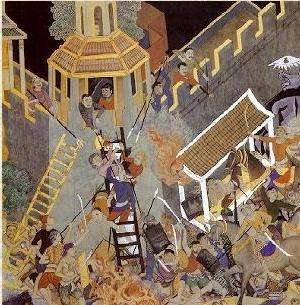
Chola invasion
The contributory factors in the decline of Srivijaya are foreign piracy and raids that disrupted the trade and security in the region. Attracted to the wealth of Srivijaya, Rajendra Chola, the Chola king from Tamil Nadu in South India, launched naval raids on ports of Srivijaya and conquered Kadaram (modern Kedah) from Srivijaya in 1025.[1]:142–143 The Cholas are known to have benefitted from both piracy and foreign trade. At times, the Chola seafaring led to outright plunder and conquest as far as Southeast Asia.[55] An inscription of King Rajendra states that he had captured the King of Kadaram, Sangrama Vijayatunggavarman, and plundered a large amount of treasures including the Vidhyadara-torana which was the jewelled 'war gate' of Srivijaya adorned with great splendour.[54]:1
With the Maharaja Sangrama Vijayottunggavarman imprisoned and most of its cities destroyed, the leaderless Srivijaya mandala entered a period of chaos and confusion. The invasion marked the end of the Sailendra dynasty rule of Srivijaya. According to the 15th-century Malay annals Sejarah Melayu, Rajendra Chola I after the successful naval raid in 1025 married Onang Kiu, the daughter of Vijayottunggavarman.[56][57] This invasion forced Srivijaya to make peace with Javanese kingdom of Kahuripan. The peace deal was brokered by the exiled daughter of Vijayottunggavarman, who managed to escape the destruction of Palembang, and came to the court of King Airlangga in East Java. She also became the queen consort of Airlangga named Dharmaprasadottungadevi and in 1035, Airlangga constructed a Buddhist monastery named Srivijayasrama dedicated to his queen consort.[58]:163
The Cholas continued a series of raids and conquests of parts of Sumatra and Malay Peninsula for the next 20 years. The expedition of Rajendra Chola I had such a lasting impression on the Malay people of the period that his name is even mentioned (in the corrupted form as Raja Chulan) in the medieval Malay chronicle, the Sejarah Melayu (Malay Annals).[56][59][60][61] Even today the Chola rule is remembered in Malaysia as many Malaysian princes have names ending with Cholan or Chulan, one such was the Raja of Perak called Raja Chulan.[62][63] This event marked the demise of the Empire and a sharp turn for the control of the trade route. For the next century, Tamil trading companies from southern India dominated the Straits region, although the domination was weaker than the control of the Srivijayan Empire.[64]
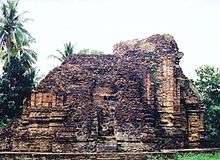
King Rajendra Chola overseas expeditions against Srivijaya was a unique event in India's history and its otherwise peaceful relations with the states of Southeast Asia. The reasons of the naval expeditions are uncertain as the sources are silent about its exact causes. Nilakanta Sastri suggests that the attacks were probably caused by Srivijaya's attempts to throw obstacles in the way of the Chola trade with the East or, more probably, a simple desire on the part of King Rajendra Chola to extend his military victories to the countries that were well known so as to add lustre to his crown.[54] It gravely weakened the Srivijayan hegemony and enabled the formation of regional kingdoms like Kediri, which were based on intensive agriculture rather than coastal and long-distance trade. With the passing of time, the regional trading center shifted from the old Srivijayan capital of Palembang to another trade centre on the island of Sumatra, Jambi, which was the centre of Malayu.[64]
Although the Cholas did not established a direct rule over Srivijayan court, Chola nobles were accepted graciously in Srivijayan court. In 1067, a Chola prince named Divakara or Devakala was sent as a Srivijayan ambassador to the Imperial Court of China. The prince who was the nephew of Rajendra Chola later was enthroned in 1070 as Kulothunga Chola I. The humiliating defeat of Srivijayan Mandala against foreign invasion, has exposed the weaknesses and vurnerability of Srivijayan allegiance and alliance model. Among the disillusioned regional polities that jump out of the wagon, Kedah was the first that rebelled against the central Srivijayan authority. As the response, Srivijaya asked the Chola's help to punish and suppress Kedah rebellion. In 1068, Virarajendra Chola launched a naval raid to help Srivijaya reclaim Kedah.[65] Virarajendra reinstated the Kedah king at the request of the Srivijayan Maharaja and Kedah accepted the Srivijayan sovereignty.[58][65] After this the Chola ruler Kulothunga Chola I became the ruler of Srivijaya which is mentioned in the Song chronicles.[66][67] This peculiar event and the strange dynamic between Srivijaya and its former nemesis, the Cholas, has confused the Chinese court, that in their report mistakenly thought that the Chola was the vassal of Srivijaya.
Return

Between 1079 and 1088, Chinese records show that Srivijaya sent ambassadors from Jambi and Palembang.[68] In 1079 in particular, an ambassador from Jambi and Palembang each visited China. Jambi sent two more ambassadors to China in 1082 and 1088.[68] That would suggest that the centre of Srivijaya frequently shifted between the two major cities during that period.[68] The Chola expeditions as well as the changing trade routes weakened Palembang, allowing Jambi to take the leadership of Srivijaya from the 11th century onwards.[69]
By the 12th century, a new dynasty called Mauli rose as the paramount of Srivijaya. The earliest reference to the new dynasty was found in Grahi inscription dated 1183 discovered in Chaiya (Grahi), Southern Thailand Malay Peninsula. The inscription bears the order of Maharaja Srimat Trailokyaraja Maulibhusana Warmadewa to the bhupati (regent) of Grahi named Mahasenapati Galanai to make a statue of Buddha weight 1 bhara 2 tula with the value of 10 gold tamlin. The artist that responsible for the creation of the statue is Mraten Sri Nano.
According to the Chinese Song Dynasty book Zhu Fan Zhi,[70] written around 1225 by Zhao Rugua, the two most powerful and richest kingdoms in the Southeast Asian archipelago were Srivijaya and Java (Kediri), with the western part (Sumatra, the Malay peninsula, and western Java/Sunda) under Srivijaya's rule and the eastern part was under Kediri's domination. It says that the people in Java followed two kinds of religions, namely Buddhism and the religion of Brahmins (Hinduism), while the people of Srivijaya followed Buddhism. The book describes the people of Java as being brave, short-tempered and willing to fight. It also notes that their favourite pastimes were cockfighting and pig fighting. The coin used as the currency then were made from a mixture of copper, silver, and tin.
Part of a series on the |
|---|
| History of Thailand |
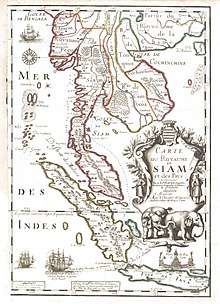 |
|
Legendary Suvarnabhumi Central Thailand Dvaravati Lavo Supannabhum Northern Thailand Singhanavati Ngoenyang Hariphunchai Southern Thailand Pan Pan Raktamaritika Langkasuka Srivijaya Tambralinga Nakhon Si Thammarat Sultanate of Pattani Kedah Sultanate Satun Reman |
| History |
|
Sukhothai Kingdom Ayutthaya Kingdom Thonburi Kingdom Rattanakosin Kingdom 1932 to 1973 Since 1973 |
|
Regional history |
|
Related topics |
|
|
Zhu fan zhi also states that Java was ruled by a maharaja and included the following "dependencies": Pai-hua-yuan (Pacitan), Ma-tung (Medang), Ta-pen (Tumapel, now Malang), Hi-ning (Dieng), Jung-ya-lu (Hujung Galuh, now Surabaya), Tung-ki (Jenggi, West Papua), Ta-kang (Sumba), Huang-ma-chu (Southwest Papua), Ma-li (Bali), Kulun (Gurun, identified as Gorong or Sorong in West Papua or an island in Nusa Tenggara), Tan-jung-wu-lo (Tanjungpura in Borneo), Ti-wu (Timor), Pingya-i (Banggai in Sulawesi), and Wu-nu-ku (Maluku).[1]:186–187 Additionally, Zhao Rugua said that Srivijaya "was still a great power at the beginning of the thirteenth century" with 15 colonies:[71] Pong-fong (Pahang), Tong-ya-nong (Terengganu), Ling-ya-si-kia (Langkasuka), Kilan-tan (Kelantan), Fo-lo-an (Dungun, eastern part of Malay Peninsula, a town within state of Terengganu), Ji-lo-t'ing (Cherating), Ts'ien-mai (Semawe, Malay Peninsula), Pa-t'a (Sungai Paka, located in Terengganu of Malay Peninsula), Tan-ma-ling (Tambralinga, Ligor or Nakhon Si Thammarat, South Thailand), Kia-lo-hi (Grahi, (Krabi) northern part of Malay peninsula), Pa-lin-fong (Palembang), Sin-t'o (Sunda), Lan-wu-li (Lamuri at Aceh), Kien-pi (Jambi) and Si-lan (Cambodia or Ceylon (?)).[1]:183–184[72][73]
Srivijaya remained a formidable sea power until the 13th century.[2] According to Cœdès, at the end of the 13th century, the empire "had ceased to exist... caused by the simultaneous pressure on its two flanks of Siam and Java."[1]:204,243
Javanese pressure
By the 13th century, Singhasari empire, the successor state of Kediri in Java, rose as a regional hegemon in maritime Southeast Asia. In the year 1275, the ambitious and able king Kertanegara, the fifth monarch of Singhasari who had been reigning since 1254, launched a naval campaign northward towards the remains of the Srivijayan mandala.[1]:198 The strongest of these Malay kingdoms was Jambi, which captured the Srivijaya capital in 1088, then the Dharmasraya kingdom, and the Temasek kingdom of Singapore, and then remaining territories. In 1288, Kertanegara's forces conquered much of Melayu states includes Palembang, Jambi as well as much of Srivijaya during the Pamalayu expedition. The Padang Roco Inscription was discovered in 1911 near the source of Batang Hari river, Padangroco.[74] The inscription which was dated 1208 Saka (1286), tell that under the order of king Kertanegara of Singhasari, a statue of Amoghapasa Lokeshvara was transported from Bhumijawa (Java) to Suvarnabhumi (Sumatra) to be erected at Dharmasraya. This gift has made the people of Suvarnabhumi rejoiced, especially their king Tribhuwanaraja Mauliwarmmadewa.
In the year 1293, the Majapahit empire, the successor state of Singhasari, ruled much of Sumatra. Prince Adityawarman was given the power over Sumatera in 1347 by Tribhuwana Wijayatunggadewi, the third monarch of Majapahit. A rebellion broke out in 1377 and was quashed by Majapahit but it left the area of southern Sumatera in chaos and desolation.
In the following years, sedimentation on the Musi river estuary cut the kingdom's capital off from direct sea access. This strategic disadvantage crippled the trade in the kingdom's capital. As the decline continued, Islam made its way to the Aceh region of Sumatra, spreading through contacts with Arab and Indian traders. By the late 13th century, the kingdom of Pasai, in northern Sumatra, converted to Islam. At the same time, Srivijayan lands in Malay Peninsula (now Southern Thailand) was briefly a tributary state of the Khmer empire and later the Sukhothai kingdom. The last inscription, on which a crown prince, Ananggavarman, son of Adityawarman, is mentioned, dates from 1374.
Last revival efforts
After decades of Javanese domination, there were several last efforts made by Sumatran rulers to revive the old prestige and fortune of Malay-Srivijayan Mandala. Several attempts to revive Srivijaya were made by the fleeing princes of Srivijaya. According to the Malay Annals, a new ruler named Sang Sapurba was promoted as the new paramount of Srivijayan mandala. It was said that after his accession to Seguntang Hill with his two younger brothers, Sang Sapurba enters into a sacred covenant with Demang Lebar Daun the native ruler of Palembang.[75] The newly installed sovereign afterwards descended from the hill of Seguntang into the great plain of Musi river, where he married Wan Sendari, the daughter of the local chief, Demang Lebar Daun. Sang Sapurba was said to have reigned in Minangkabau lands.
According to Visayan legends, in the 1200s, there was a resistance movement of Srivijayan datus aimed against the encroaching powers of the Hindu Chola and Majapahit empires. The datus migrated to and organized their resistance movement from the Visayas islands of the Philippines which was named after their Srivijayan homeland.[76] 10 Datus, led by Datu Puti established a rump state of Srivijaya, called Madja-as in the Visayas islands.[77] This rump state waged war against the Chola empire and Majapahit and also raided China,[78] before they were eventually assimilated into a Spanish empire that expanded to the Philippines from Mexico.
In 1324, a prince of Srivijaya origin, Sri Maharaja Sang Utama Parameswara Batara Sri Tribuwana (Sang Nila Utama) founded the ancient Kingdom of Singapura (Temasek). Tradition mentioned that he is related to Sang Sapurba. He maintained control over Temasek for 48 years. He was recognised as ruler over Temasek by an envoy of the Chinese Emperor sometime around 1366. He was succeeded by his son Paduka Sri Pekerma Wira Diraja (1372–1386) and grandson, Paduka Seri Rana Wira Kerma (1386–1399). In 1401, the last ruler, Paduka Sri Maharaja Parameswara was expelled from Temasek by the forces from Majapahit or Ayutthaya. He later headed north and founded Sultanate of Malacca in 1402.[79] The Sultanate of Malacca succeeded Srivijaya Empire as a Malay political entity in the archipelago.[80][81]
Government and economy
Political administration
The 7th century Telaga Batu inscription, discovered in Sabokingking, Palembang, testifies to the complexity and stratified titles of the Srivijayan state officials. These titles are mentioned: rājaputra (princes, lit: sons of king), kumārāmātya (ministers), bhūpati (regional rulers), senāpati (generals), nāyaka (local community leaders), pratyaya (nobles), hāji pratyaya (lesser kings), dandanayaka (judges), tuhā an vatak (workers inspectors), vuruh (workers), addhyāksi nījavarna (lower supervisors), vāsīkarana (blacksmiths/weapon makers), cātabhata (soldiers), adhikarana (officials), kāyastha (store workers), sthāpaka (artisans), puhāvam (ship captains), vaniyāga (traders), marsī hāji (king's servants), hulun hāji (king's slaves).[82]
During its formation, the empire was organised in three main zones — the estuarine capital region centred on Palembang, the Musi River basin which served as hinterland and source of valuable goods, and rival estuarine areas capable of forming rival power centres. These rival estuarine areas, through raids and conquests, were held under Srivijayan power, such as the Batanghari estuarine (Malayu in Jambi). Several strategic ports also included places like Bangka Island (Kota Kapur), ports and kingdoms in Java (highly possible Tarumanagara and Kalingga), Kedah and Chaiya in Malay peninsula, and Lamuri and Pannai in northern Sumatra. There are also reports mentioning the Java-Srivijayan raids on Southern Cambodia (Mekong estuarine) and ports of Champa.
After its expansion to the neighbouring states, the Srivijayan empire was formed as a collection of several Kadatuans (local principalities), which swore allegiance to the central ruling powerful Kadatuan ruled by the Srivijayan Maharaja. The political relations and system relating to its realms is described as a mandala model, typical of that of classical Southeast Asian Hindu-Buddhist kingdoms. It could be described as federation of kingdoms or vassalised polity under a centre of domination, namely the central Kadatuan Srivijaya. The polity was defined by its centre rather than its boundaries and it could be composed of numerous other tributary polities without undergoing further administrative integration.[83]
The relations between the central kadatuan and its member (subscribers) kadatuans were dynamic. As such, the status would shift over generations. Minor trading ports throughout the region were controlled by local vassal rulers in place on behalf of the king. They also presided over harvesting resources from their respective regions for export. A portion of their revenue was required to be paid to the king.[84] They were not allowed to infringe upon international trade relations, but the temptation of keeping more money to themselves eventually led foreign traders and local rulers to conduct illicit trading relations of their own.[85] Other sources claim that the Champa invasion had weakened the central government significantly, forcing vassals to keep the international trade revenue for themselves.[84]
In addition to coercive methods through raids and conquests and being bound by pasumpahan (oath of allegiance), the royalties of each kadatuan often formed alliances through dynastic marriages. For example, a previously suzerained kadatuan over time might rise in prestige and power, so that eventually its ruler could lay claim to be the maharaja of the central kadatuan. The relationship between Srivijayan in Sumatra (descendants of Dapunta Hyang Sri Jayanasa) and Sailendras in Java exemplified this political dynamic.
Economy and commerce

The main interest of Srivijayan foreign economic relation was to secure a highly lucrative trade agreement to serve a large Chinese market, that span from Tang to Song dynasty era. In order to participate in this trade agreement, Srivijaya involved in tributary relation with China, in which they sent numbers of envoys and embassies to secure the Chinese court's favour. The port of Srivijaya served as an important entrepôt in which valuable commodities from the region and beyond are collected, traded and shipped. Rice, cotton, indigo and silver from Java; aloes, resin, camphor, ivory and rhino's tusks, tin and gold from Sumatra; rattan, rare timber, gems and precious stones from Borneo; exotic birds and rare animals, iron, sappan, sandalwood and rare spices from Eastern Indonesian archipelago; various spices of Southeast Asia and India; also Chinese ceramics, lacquerware, brocade, fabrics, silks and Chinese artworks are among valuable commodities being traded in Srivijayan port. What goods were actually native to Srivijaya is currently being disputed due to the volume of cargo that regularly passed through the region from India, China, and Arabia. Foreign traders stopped to trade their cargo in Srivijaya with other merchants from Southeast Asia and beyond. It was an easy location for traders from different regions to meet as opposed to visiting each other directly. This system of trade has led researchers to conjecture that the actual native products of Srivijaya were far less than what was originally recorded by Chinese and Arabic traders of the time. It may be that cargo sourced from foreign regions accumulated in Srivijaya. The accumulation of particular foreign goods that were easily accessible and in large supply might have given the impression they were products of Srivijaya. This could also work in the opposite direction with some native Srivijayan goods being mistaken as foreign commodities.[86][84]
In the world of commerce, Srivijaya rose rapidly to be a far-flung empire controlling the two passages between India and China, namely the Sunda Strait from Palembang and the Malacca Strait from Kedah. Arab accounts state that the empire of the Srivijayan Maharaja was so vast that the swiftest vessel would not have been able to travel round all its islands within two years. The islands the accounts referred to produced camphor, aloes, sandal-wood, spices like cloves, nutmegs, cardamom and cubebs, as well as ivory, gold and tin, all of which equalled the wealth of the Maharaja to any king in India.[87] The Srivijayan government centralized the sourcing and trading of native and foreign goods in “warehouses” which streamlined the trade process by making a variety of products easily accessible in one area.
Ceramics were a major trade commodity between Srivijaya and China with shard artifacts found along the coast of Sumatra and Java. It is assumed that China and Srivijaya may have had an exclusive ceramics trade relationship because particular ceramic shards can only be found at their point of origin, Guangzhou, or in Indonesia, but nowhere else along the trade route.[86] When trying to prove this theory, there has been some discrepancies with the dating of said artifacts. Ceramic sherds found around the Geding Suro temple complex have been revealed to be much more recent than previously assumed. A statuette found in the same area did align with Srivijayan chronology, but it has been suggested that this is merely coincidence and the product was actually brought to the region recently.[20]
Other than fostering the lucrative trade relations with India and China, Srivijaya also established commerce links with Arabia. In a highly plausible account, a messenger was sent by Maharaja Sri Indravarman to deliver a letter to Caliph Umar ibn AbdulAziz of Ummayad in 718. The messenger later returned to Srivijaya with a Zanji (a black female slave from Zanj), a gift from the Caliph to the Maharaja. Later, a Chinese chronicle made a mention of Shih-li-t-'o-pa-mo (Sri Indravarman) and how the Maharaja of Shih-li-fo-shih had sent the Chinese Emperor a ts'engchi (Chinese spelling of the Arabic Zanji) as a gift in 724.[88]
Arab writers of the 9th and 10th century, in their writings, considered the king of Al-Hind (India and to some extent might include Southeast Asia) as one of the 4 great kings in the world.[89][90] The reference to the kings of Al-Hind might have also included the kings of Southeast Asia; Sumatra, Java, Burma and Cambodia. They are, invariably, depicted by the Arabs writers as extremely powerful and being equipped with vast armies of men, horses and having tens of thousands of elephants.[89][90] They were also said to be in possession of vast treasures of gold and silver.[89][90] Trading records from the 9th and 10th centuries mention Srivijaya, but do not expand upon regions further east thus indicating that Arabic traders were not engaging with other regions in Southeast Asia thus serving as further evidence of Srivijaya’s important role as a link between the two regions.[86]
The currency of the empire were gold and silver coins embossed with the image of the sandalwood flower (of which Srivijaya had a trade monopoly on) and the word “vara,” or “glory,” in Sanskrit.[84][91] Other items could be used to barter with, such as porcelain, silk, sugar, iron, rice, dried galangal, rhubarb, and camphor.[84] According to Chinese records, gold was a large part of Srivijaya. These texts describe that the empire, also referred to as “Jinzhou” which translates to “Gold Coast”, used gold vessel in ritual offering and that, as a vassal to China, brought “golden lotus bowls” as luxurious gifts to the Emperor during the Song Dynasty.[92] Some Arabic records that the profits acquired from trade ports and levies was converted into gold and was hidden by the King in the royal pond.[4]
Thalassocratic empire

The Srivijayan empire was a coastal trading centre and was a thalassocracy. As such, its influence did not extend far beyond the coastal areas of the islands of Southeast Asia.
Srivijaya benefited from the lucrative maritime trade between China and India as well as trading in products such as Maluku spices within the Malay Archipelago. Serving as Southeast Asia's main entrepôt and gaining trade patronage by the Chinese court, Srivijaya was constantly managing its trade networks and, yet, always wary of potential rival ports of its neighbouring kingdoms. A majority of the revenue from international trade was used to finance the military which was charged with the responsibility of protecting the ports. Some records even describe the use of iron chains to prevent pirate attacks.[84] The necessity to maintain its trade monopoly had led the empire to launch naval military expeditions against rival ports in Southeast Asia and to absorb them into Srivijaya's sphere of influence. The port of Malayu in Jambi, Kota Kapur in Bangka island, Tarumanagara and the port of Sunda in West Java, Kalingga in Central Java, the port of Kedah and Chaiya in Malay peninsula are among the regional ports that were absorbed within Srivijayan sphere of influence. A series of Javan-Srivijaya raids on the ports of Champa and Cambodia was also part of its effort to maintain its monopoly in the region by sacking its rival ports.
The maritime prowess was recorded in a Borobudur bas relief of Borobudur ship, the 8th century wooden double outrigger vehicles of Maritime Southeast Asia. The function of an outrigger is to stabilise the ship. The single or double outrigger canoe is the typical feature of the seafaring Austronesians vessels and the most likely type of vessel used for the voyages and explorations across Southeast Asia, Oceania, and Indian Ocean. The ships depicted at Borobudur most likely were the type of vessels used for inter-insular trades and naval campaigns by Sailendra and Srivijaya.
The Srivijayan empire exercised its influence mainly around the coastal areas of Southeast Asia, with the exception of contributing to the population of Madagascar 3,300 miles (8,000 kilometres) to the west.[45] The migration to Madagascar was estimated to have taken place 1,200 years ago around 830.[46]
Culture and society
Srivijaya-Palembang’s significance both as a center for trade and for the practice of Vajrayana Buddhism has been established by Arab and Chinese historical records over several centuries. Srivijaya' own historical documents, inscriptions in Old Malay, are limited to the second half of the 7th century. The inscriptions uncover the hierarchical leadership system, in which the king is served by many other high-status officials.[93] A complex, stratified, cosmopolitan and prosperous society with refined tastes in art, literature and culture, with complex set of rituals, influenced by Mahayana Buddhist faith; blossomed in the ancient Srivijayan society. Their complex social order can be seen through studies on the inscriptions, foreign accounts, as well as rich portrayal in bas-reliefs of temples from this period. Their accomplished artistry was evidenced from a number of Srivijayan Art Mahayana Buddhist statues discovered in the region. The kingdom had developed a complex society; which characterised by heterogeneity of their society, inequality of social stratification, and the formation of national administrative institution in their kingdom. Some forms of metallurgy were used as jewelry, currency (coins), as status symbols—for decorative purposes.[94]
Art and culture
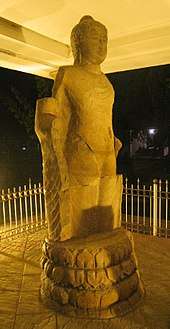
Trade allowed the spread of art to proliferate. Some art was heavily influenced by Buddhism, further spreading religion and ideologies through the trade of art. The Buddhist art and architecture of Srivijaya was influenced by the Indian art of the Gupta Empire and Pala Empire. This is evident in the Indian Amaravati style Buddha statue located in Palembang. This statue, dating back to the 7th and 8th centuries, exists as proof of the spread of art, culture, and ideology through the medium of trade.[95][84] According to various historical sources, a complex and cosmopolitan society with a refined culture, deeply influenced by Vajrayana Buddhism, flourished in the Srivijayan capital. The 7th century Talang Tuwo inscription described Buddhist rituals and blessings at the auspicious event of establishing public park. This inscription allowed historians to understand the practices being held at the time, as well as their importance to the function of Srivijayan society. Talang Tuwo serves as one of the world’s oldest inscriptions that talks about the environment, highlighting the centrality of nature in Buddhist religion and further, Srivijayan society. The Kota Kapur Inscription mentions Srivijaya military dominance against Java. These inscriptions were in the Old Malay language, the language used by Srivijaya and also the ancestor of Malay and Indonesian language. Since the 7th century, the Old Malay language has been used in Nusantara (Malay-Indonesian archipelago), marked by these Srivijayan inscriptions and other inscriptions using old Malay language in the coastal areas of the archipelago, such as those discovered in Java. The trade contact carried by the traders at the time was the main vehicle to spread Malay language, since it was the language used amongst the traders. By then, Malay language become lingua franca and was spoken widely by most people in the archipelago.[96][97][84]
However, despite its economic, cultural and military prowess, Srivijaya left few archaeological remains in their heartlands in Sumatra, in contrast with Srivijayan episode in Central Java during the leadership of Sailendras that produced numerous monuments; such as the Kalasan, Sewu and Borobudur mandala. The Buddhist temples dated from Srivijayan era in Sumatra are Muaro Jambi, Muara Takus and Biaro Bahal.
Some Buddhist sculptures, such as Buddha Vairocana, Boddhisattva Avalokiteshvara and Maitreya, were discovered in numerous sites in Sumatra and Malay Peninsula. These archaeological findings such as stone statue of Buddha discovered in Bukit Seguntang, Palembang,[98] Avalokiteshvara from Bingin Jungut in Musi Rawas, bronze Maitreya statue of Komering, all discovered in South Sumatra. In Jambi, golden statue of Avalokiteshvara were discovered in Rataukapastuo, Muarabulian.[99] In Malay Peninsula the bronze statue of Avalokiteshvara of Bidor discovered in Perak Malaysia,[100] and Avalokiteshvara of Chaiya in Southern Thailand.[101] All of these statues demonstrated the same elegance and common style identified as "Srivijayan art" that reflects close resemblance — probably inspired — by both Indian Amaravati style and Javanese Sailendra art (c. 8th to 9th century).[102] The difference in material, yet overarching theme of Buddhism found across the region supports the spread of Buddhism through trade. Although each country put their own spin on an idea, it is evident how trade played a huge role in spreading ideas throughout Southeast Asia, especially in Srivijaya. The commonality of Srivijayan art exists in Southeast Asian sites, proving their influence on art and architecture across the region. Without trade, Srivijayan art could not have proliferated, and cross-cultural exchanges of language and style could not have been achieved.
After the bronze and Iron Age, an influx of bronze tools and jewelry spread throughout the region. The different styles of bangles and beads represent the different regions of origin and their own specific materials and techniques used . Chinese artworks were one of the main items traded in the region, spreading art styles enveloped in ceramics, pottery, fabrics, silk, and artworks.[84]
Religion
— from I-tsing's A Record of Buddhist Practices Sent Home from the Southern Sea.[103]
Remnants of Buddhist shrines (stupas) near Palembang and in neighboring areas aid researchers in their understanding of the Buddhism within this society. Srivijaya and its kings were instrumental in the spread of Buddhism as they established it in places they conquered like Java, Malaya, and other lands.[104] People making pilgrimages were encouraged to spend time with the monks in the capital city of Palembang on their journey to India.[104]
Other than Palembang, in Srivijayan realm of Sumatra, three archaeological sites are notable for their Buddhist temple density. They are Muaro Jambi by the bank of Batang Hari River in Jambi province; Muara Takus stupas in Kampar River valley of Riau province; and Biaro Bahal temple compound in Barumun and Pannai river valleys, North Sumatra province. It is highly possible that these Buddhist sites served as sangha community; the monastic Buddhist learning centers of the region, which attracts students and scholars from all over Asia.
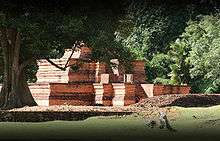
250 years before I Ching, scholar and traveler, Fa Xian, did not notice the heavy hand of Buddhism within the Srivijayan region. Fa Xian, however, did witness the maritime competition over the region and observed the rise of Srivijaya as a Thalassocracy.[92] I-Tsing stayed in Srivijaya for six months and studied Sanskrit. According to I-Tsing, within Palembang there were more than 1000 monks studying for themselves and training traveling scholars who were going from India to China and vice versa. These travelers were primarily situated in Palembang for long periods of time due to waiting for Monsoon winds to help further their journey.[105]
A stronghold of Vajrayana Buddhism, Srivijaya attracted pilgrims and scholars from other parts of Asia. These included the Chinese monk I Ching, who made several lengthy visits to Sumatra on his way to study at Nalanda University in India in 671 and 695, and the 11th century Bengali Buddhist scholar Atisha, who played a major role in the development of Vajrayana Buddhism in Tibet. I Ching, also known as Yijing, and other monks of his time practised a pure version of Buddhism although the religion allowed for culture changes to be made.[106] He is also given credit for translating Buddhist text which has the most instructions on the discipline of the religion.[107] I Ching reports that the kingdom was home to more than a thousand Buddhist scholars; it was in Srivijaya that he wrote his memoir of Buddhism during his own lifetime. Travellers to these islands mentioned that gold coins were in use in the coastal areas but not inland.
A notable Srivijayan and revered Buddhist scholar is Dharmakirti who taught Buddhist philosophy in Srivijaya and Nalanda. The language diction of many inscriptions found near where Srivijaya once reigned incorporated Indian Tantric conceptions. This evidence makes it clear the relationship of the ruler and the concept of bodhisattva—one who was to become a Buddha. This is the first evidence seen in the archaeological record of a Southeast Asian ruler (or king) regarded as a religious leader/figure.
One thing researchers have found Srivijaya to be lacking is an emphasis in art and architecture. While neighboring regions have evidence of intricate architecture, such as the Borobudur temple built in 750-850 AD under the Saliendra Dynasty, Palembang lacks Buddhist stupas or sculpture.[108] Though this does not accurately reflect Buddhist influence.
Relations with regional powers
Part of a series on the |
||||||||||||||||||
|---|---|---|---|---|---|---|---|---|---|---|---|---|---|---|---|---|---|---|
| History of Singapore | ||||||||||||||||||
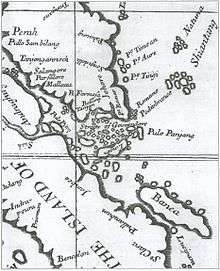 | ||||||||||||||||||
|
Early history (pre-1819)
|
||||||||||||||||||
|
British colonial era (1819–1942)
|
||||||||||||||||||
|
Japanese Occupation (1942–45)
|
||||||||||||||||||
|
Post-war period (1945–62)
|
||||||||||||||||||
|
Internal self-government (1955–63)
|
||||||||||||||||||
|
Merger with Malaysia (1963–65) |
||||||||||||||||||
|
Republic of Singapore (1965–present)
|
||||||||||||||||||
|
| ||||||||||||||||||
Although historical records and archaeological evidence are scarce, it appears that by the 7th century, Srivijaya had established suzerainty over large areas of Sumatra, western Java and much of the Malay Peninsula. The oldest accounts of the empire come from Arabic and Chinese traders who noted in their travel logs the importance of the empire in regional trade.[109] Its location was instrumental in developing itself as a major connecting port between China and the Middle East and Southeast Asia. Control of the Malacca and Sunda Straits meant it controlled both the spice route traffic and local trade, charging a toll on passing ships. Serving as an entrepôt for Chinese, Malay, and Indian markets, the port of Palembang, accessible from the coast by way of a river, accumulated great wealth. Instead of traveling the entire distance from the Middle East to China, which would have taken about a year with the assistance of monsoon winds, it was easier to stop somewhere in the middle, Srivijaya. It took about half a year from either direction to reach Srivijaya which was a far more effective and efficient use of manpower and resources. A round trip from one end to Srivijaya and back would take the same amount of time to go the entire distance one way. This theory has been supported by evidence found in two local shipwrecks. One off the coast of Belitung, an island east of Sumatra, and another near Cirebon, a coastal city on the nearby island of Java. Both ships carried a variety of foreign cargo and, in the case of the Belitung wreck, had foreign origins.[86]
The Melayu Kingdom was the first rival power centre absorbed into the empire, and thus began the domination of the region through trade and conquest in the 7th through the 9th centuries. The Melayu Kingdom's gold mines up in the Batang Hari River hinterland were a crucial economic resource and may be the origin of the word Suvarnadvipa, the Sanskrit name for Sumatra. Srivijaya helped spread the Malay culture throughout Sumatra, the Malay Peninsula, and western Borneo. Its influence waned in the 11th century. It was then in frequent conflict with, and ultimately subjugated by, the Javanese kingdoms of Singhasari and, later, Majapahit.[110] This was not the first time the Srivijayans had a conflict with the Javanese. According to historian Paul Michel Munoz, the Javanese Sanjaya dynasty was a strong rival of Srivijaya in the 8th century when the Srivijayan capital was located in Java. The seat of the empire moved to Muaro Jambi in the last centuries of Srivijaya's existence.
The Khmer Empire might also have been a tributary state in its early stages. The Khmer king, Jayavarman II, was mentioned to have spent years in the court of Sailendra in Java before returning to Cambodia to rule around 790. Influenced by the Javanese culture of the Sailendran-Srivijayan mandala (and likely eager to emulate the Javanese model in his court), he proclaimed Cambodian independence from Java and ruled as devaraja, establishing Khmer empire and starting the Angkor era.[111]
Some historians claim that Chaiya in Surat Thani Province in southern Thailand was, at least temporarily, the capital of Srivijaya, but this claim is widely disputed. However, Chaiya was probably a regional centre of the kingdom. The temple of Borom That in Chaiya contains a reconstructed pagoda in Srivijaya style.[72]
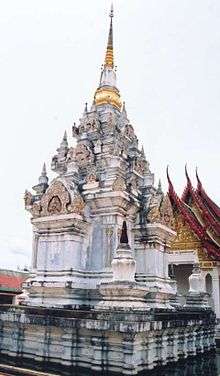
Wat Phra Boromathat Chaiya is highlighted by the pagoda in Srivijaya style, elaborately restored, and dating back to the 7th century. The Buddha relics are enshrined in the chedi or stupa. In the surrounding chapels are several Buddha statues in Srivijaya style, as it was labelled by Damrong Rajanubhab in his Collected Inscriptions of Siam, which is now attributed to Wat Hua Wiang in Chaiya. Dated to the year 697 of the Mahasakkarat era (775), the inscriptions on a bai sema tells about the King of Srivijaya having erected three stupas at that site; which are possibly the ones at Wat Phra Borom That. However, it is also possible that the three stupas referred to are located at Wat Hua Wiang (Hua Wiang temple), Wat Lhong (Lhong temple) and Wat Kaew (Kaew temple) which are also found in Chaiya. After the fall of the Srivijaya, the area was divided into the cities (mueang) Chaiya, Thatong (now Kanchanadit) and Khirirat Nikhom.
Srivijaya also maintained close relations with the Pala Empire in Bengal. The Nalanda inscription, dated 860, records that Maharaja Balaputra dedicated a monastery at the Nalanda university in the Pala territory.[1]:109 The relation between Srivijaya and the Chola dynasty of southern India was initially friendly during the reign of Raja Raja Chola I. In 1006, a Srivijayan Maharaja from the Sailendra dynasty, king Maravijayattungavarman, constructed the Chudamani Vihara in the port town of Nagapattinam.[112] However, during the reign of Rajendra Chola I the relationship deteriorated as the Chola Dynasty started to attack Srivijayan cities.[113]
The reason for this sudden change in the relationship with the Chola kingdom is not really known. However, as some historians suggest, it would seem that the Khmer king, Suryavarman I of the Khmer Empire, had requested aid from Emperor Rajendra Chola I of the Chola dynasty against Tambralinga.[114] After learning of Suryavarman's alliance with Rajendra Chola, the Tambralinga kingdom requested aid from the Srivijaya king, Sangrama Vijayatungavarman.[114][115] This eventually led to the Chola Empire coming into conflict with the Srivijiya Empire. The conflict ended with a victory for the Chola and heavy losses for Srivijaya and the capture of Sangramavijayottungavarman in the Chola raid in 1025.[1]:142–143[114][115] During the reign of Kulothunga Chola I, Srivijaya had sent an embassy to the Chola Dynasty.[56][116]
Legacy
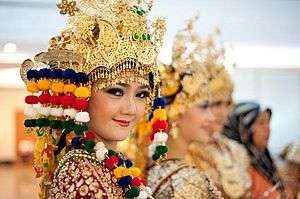
Although Srivijaya left few archaeological remains and was almost forgotten in the collective memory of the Malay people, the rediscovery of this ancient maritime empire by Cœdès in the 1920s raised the notion that it was possible for a widespread political entity to have thrived in Southeast Asia in the past. Modern Indonesian historian has invoked Srivijaya not merely as a glorification of the past, but as a frame of reference and example of how ancient globalization, foreign relations and maritime trade, has shaped Asian civilization.[117]
The most important legacy of Srivijayan empire was probably its language. For centuries, Srivijaya, through its expansion, economic power and military prowess, was responsible for the widespread of Old Malay throughout the Malay-Indonesian archipelago. It was the working language of traders and it was used in various ports, and marketplaces in the region.[118] The language of Srivijayan had probably paved the way for the prominence of the present-day Malay and Indonesian language, now the official language of Malaysia, Brunei and Singapore and the unifying language of modern Indonesia.
According to the Malay Annals, the founder of Malacca Sultanate Parameswara claimed to be a member of the Palembang Srivijaya lineage. That shows that even in the 15th century, the prestige of Srivijaya still remained and was used as a source for political legitimacy in the region.
Modern Indonesian nationalists have also invoked the name of Srivijaya, along with Majapahit, as a source of pride in Indonesia's past greatness.[119] Srivijaya has become the focus of national pride and regional identity, especially for the people of Palembang, South Sumatra province, and the Malay people as a whole.[3] For the people of Palembang, Srivijaya has also become a source of artistic inspiration for Gending Sriwijaya song and traditional dance.
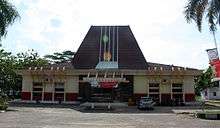
The same situation also happened in southern Thailand, where Sevichai (Thai: Srivijaya) dance was recreated in accordance with the art and culture of ancient Srivijaya. Today, the Srivijayan legacy is also celebrated and identified with Malay minority of Southern Thailand. In Thailand, the Srivijayan art was associated with Javanese art and architecture, which probably demonstrate the Sailendra influences over Java, Sumatra and the Peninsula. The examples of Srivijayan style temples are Phra Borom Mahathat at Chaiya constructed in Javanese style made of brick and mortar (c. 9th – 10th century), Wat Kaew Pagoda at Chaiya, also of Javanese form and Wat Long Pagoda. The original Wat Mahathat at Nakhon Si Thammarat (a Srivijayan city) was subsequently encased by a larger Sri Lanka styled building.[120]
In Indonesia, Srivijaya is a street name in many cities and has become synonymous with Palembang and South Sumatra. Srivijaya University, established in 1960 in Palembang, was named after Srivijaya. Kodam Sriwijaya (a military commando area unit), PT Pupuk Sriwijaya (a fertiliser company), Sriwijaya Post (a Palembang-based newspaper), Sriwijaya Air (an airline), Gelora Sriwijaya Stadium, and Sriwijaya F.C. (Palembang football club) were also all named to honour this ancient maritime empire. On 11 November 2011, during the opening ceremony of 2011 Southeast Asian Games in Gelora Sriwijaya Stadium, Palembang, a colossal dance performance titled "Srivijaya the Golden Peninsula" was performed featuring Palembang traditional dances and also an actual sized replica of an ancient ship to describe the glory of the maritime empire.[121][122] In popular culture, Srivijaya has become the sources on inspiration for numbers of fictional feature films, novels and comic books. The 2013 film Gending Sriwijaya for example, took place three centuries after the fall of Srivijaya, telling the story about the court intrigue amidst the effort to revive the fallen empire.[123]
List of kings
| Date | Name | Capital | Stone inscription or embassies to China and events |
|---|---|---|---|
| 683 | Dapunta Hyang Sri Jayanasa | Srivijaya | Kedukan Bukit (682), Talang Tuwo (684), and Kota Kapur inscriptions
Malayu conquest, Central Java conquest[1]:82–83 |
| 702 | Indravarman
Che-li-to-le-pa-mo |
Srivijaya
Shih-li-fo-shih |
Embassies 702, 716, 724 to China[1]:83–84
Embassies to Caliph Muawiyah I and Caliph Umar bin Abdul Aziz |
| 728 | Rudra Vikrama
Liu-t'eng-wei-kung |
Srivijaya
Shih-li-fo-shih |
Embassie 728, 742 to China[1]:84 |
| No information for the period 742–775 | |||
| 775 | Dharmasetu or Vishnu | Java | Nakhon Si Thammarat (Ligor),[1]:84 Vat Sema Muang |
| 775 | Dharanindra | Java | Ligor, started to build Borobudur in 770,
conquered South Cambodia |
| 782 | Samaragrawira | Java | Ligor, Arabian text (790), continued the construction of Borobudur |
| 792 | Samaratungga | Java | Karangtengah inscription (824), 802 lost Cambodia, 825 completion of Borobudur |
| 835 | Balaputradewa | Srivijaya
San-fo-ts'i |
Lost Central Java, moved to Srivijaya
Nalanda inscription (860) |
| No information for the period 835–960 | |||
| 960 | Sri Udayadityavarman
Si-li-Hu-ta-hsia-li-tan Shih-li Wu-yeh |
Srivijaya
San-fo-ts'i |
Chinese Embassies 960, 962[1]:131 |
| 980 | Haji
Hsia-ch'ih |
Srivijaya
San-fo-ts'i |
Chinese Embassies 980, 983[1]:132 |
| 988 | Sri Cudamani Warmadewa
Se-li-chu-la-wu-ni-fu-ma-tian-hwa |
Srivijaya
San-fo-ts'i |
Chinese Embassies 988,992,1003,1004[1]:132,141
Javanese King Dharmawangsa attack of Srivijaya, building of temple for Chinese Emperor, Tanjore Inscription or Leiden Inscription (1044), building of temple at Nagapattinam with revenue from Rajaraja Chola I |
| 1006, 1008 | Sri Maravijayottungavarman
Se-li-ma-la-pi |
Srivijaya
San-fo-ts'i |
Constructed the Chudamani Vihara in Nagapattinam, India in 1006.[112]
Chinese Embassies 1008,1016[1]:141–142 |
| 1017 | Sumatrabhumi | Srivijaya
San-fo-ts'i |
Embassy 1017 |
| 1025 | Sangrama Vijayatunggavarman[1]:142 | Srivijaya
San-fo-ts'i |
Chola invasion of Srivijaya, captured by Rajendra Chola
Chola Inscription on the temple of Rajaraja, Tanjore |
| 1028 | Sri Deva
Shih-li Tieh-hua |
Palembang
Pa-lin-fong |
Chinese Embassy 1028[1]:143
Building of Tien Ching temple, Kuang Cho (Kanton) for Chinese Emperor |
| 1078 | Kulothunga Chola I
Ti-hua-ka-lo |
Palembang
Pa-lin-fong |
Embassy 1077[1]:148 |
| No information for the period 1080–1155 | |||
| 1156 | Rajaraja Chola II | Palembang
Pa-lin-fong |
Larger Leyden Plates |
| 1183 | Srimat Trailokyaraja Maulibhusana Warmadewa | Jambi, Dharmasraya Kingdom | Bronze Buddha Chaiya 1183[1]:179 |
| No information for the period 1183–1275 | |||
| 1286 | Srimat Tribhuwanaraja Mauli Warmadewa | Jambi, Dharmasraya Kingdom | Padang Roco inscription 1286, Pamalayu expedition 1275–1293 |
References
- 1 2 3 4 5 6 7 8 9 10 11 12 13 14 15 16 17 18 19 20 21 22 23 24 Coedès, George (1968). Walter F. Vella, ed. The Indianized States of Southeast Asia. trans.Susan Brown Cowing. University of Hawaii Press. ISBN 978-0-8248-0368-1.
- 1 2 3 Munoz, Paul Michel (2006). Early Kingdoms of the Indonesian Archipelago and the Malay Peninsula. Singapore: Editions Didier Millet. p. 171. ISBN 981-4155-67-5.
- 1 2 Mohd Hazmi Mohd Rusli (31 August 2015). "The unsung Malay history". Astro Awani.
- 1 2 Laet, Sigfried J. de; Herrmann, Joachim (1994). History of Humanity. Routledge.
- ↑ Munoz. Early Kingdoms. p. 122.
- ↑ Zain, Sabri. "Sejarah Melayu, Buddhist Empires".
- ↑ Peter Bellwood; James J. Fox; Darrell Tryon (1995). "The Austronesians: Historical and Comparative Perspectives".
- 1 2 3 Munoz. Early Kingdoms. p. 117.
- ↑ Glashoff, Klaus. "Sanskrit Dictionary for Spoken Sanskrit". spokensanskrit.org. Retrieved 2018-10-04.
- ↑ Glashoff, Klaus. "Sanskrit Dictionary for Spoken Sanskrit". spokensanskrit.org. Retrieved 2018-10-04.
- ↑ "Srivijaya: A primer - Part 1 | SEAArch - Southeast Asian Archaeology". SEAArch - Southeast Asian Archaeology. 2007-06-07. Retrieved 2018-10-04.
- ↑ Taylor. Indonesia. p. 29.
- 1 2 Taylor, Jean Gelman (2003). Indonesia: Peoples and Histories. New Haven and London: Yale University Press. pp. 8–9. ISBN 0-300-10518-5.
- ↑ Krom, N.J. (1938). "Het Hindoe-tijdperk". In F.W. Stapel. Geschiedenis van Nederlandsch Indië. Amsterdam: N.V. U.M. Joost van den Vondel. vol. I p. 149.
- 1 2 3 4 Munoz. Early Kingdoms. p. 114.
- ↑ Munoz. Early Kingdoms. p. 102.
- ↑ Krom, N.J. (1943). Het oude Java en zijn kunst (2nd ed.). Haarlem: Erven F. Bohn N.V. p. 12.
- ↑ Drs. R. Soekmono (1973). Pengantar Sejarah Kebudayaan Indonesia 2 (in Indonesian) (2nd ed.). Yogyakarta: Penerbit Kanisius. p. 38. ISBN 9789794132906.
- ↑ Reynold Sumayku (17 September 2013). "Konsep Mendesa di Ibu Kota Sriwijaya, Sampai kini, konsep ibu kota Sriwijaya masih dapat disaksikan". National Geographic Indonesia (in Indonesian).
- 1 2 Bronson, Bennet; Wisseman, Jan (17 April 1975). "Palembang as Srivijaya The Lateness of Early Cities in Southern Southeast Asia". Asian Perspectives. 19 (2): 220–239.
- ↑ Bronson, Bennet (1977). "Exchange at the Upstream and Downstream Ends: Notes toward Functional Model of the Coastal State in Southeast Asia". Economic Exchange and Social Interaction in Southeast Asia: 39–52.
- ↑ Ahmad Rapanie, Cahyo Sulistianingsih, Ribuan Nata, "Kerajaan Sriwijaya, Beberapa Situs dan Temuannya", Museum Negeri Sumatera Selatan, Dinas Pendidikan Provinsi Sumatera Selatan.
- ↑ "Peneliti UI Temukan Bukti Kerajaan Sriwijaya di Jambi" (in Indonesian). 15 July 2013.
- ↑ "Muaro Jambi Temple: The Legacy of Ancient Jambi". 25 September 2011. Archived from the original on 30 June 2013. Retrieved 3 July 2013.
- ↑ Syofiardi Bachyul Jb (November 25, 2014). "Muarajambi Temple: Jambi's monumental mystery".
- ↑ Takashi Suzuki (25 December 2012). "Śrīvijaya―towards ChaiyaーThe History of Srivijaya". Retrieved 6 March 2013.
- ↑ Chihara, Daigorol; Giebel, Rolf W. (1996). Hindu-Buddhist Architecture in Southeast Asia. Brill.
- ↑ Jermsawatdi, Promsak (1979). Thai Art with Indian Influences. Abhinav Publications.
- ↑ Chand Chirayu Rajani (1974). "Background To The Sri Vijaya Story-Part" (PDF). Journal of the Siam Society. 62: 174–211.
- ↑ According to Coedès, siddhayatra refers to some "magic potion". An alternative translation, however, is possible: Zoetmulder's Dictionary of Old Javanese (1995) renders it as "a prosperous journey".
- ↑ Farrington, Karen. Historical Atlas of Empires. New York: Checkmark Books, 2002. 101. Print
- ↑ Munoz. Early Kingdoms. p. 124.
- ↑ Munoz. Early Kingdoms. p. 113.
- ↑ Munoz. Early Kingdoms. p. 125.
- 1 2 Munoz. Early Kingdoms. p. 132.
- ↑ Zakharov, Anton O. (August 2012). "The Sailendras Reconsidered" (PDF). Institute of Southeast Asian Studies. Singapore.
- ↑ Munoz. Early Kingdoms. p. 130.
- ↑ Munoz, Paul Michel (2006). Early Kingdoms of the Indonesian Archipelago and the Malay Peninsula. Singapore: Editions Didier Millet. pp. 130–131. ISBN 981-4155-67-5.
- ↑ Munoz. Early Kingdoms. p. 140.
- 1 2 3 4 Cœdès, George (1968). The Indianized states of Southeast Asia. University of Hawaii Press. ISBN 9780824803681.
- ↑ Munoz, Paul Michel (2006). Early Kingdoms of the Indonesian Archipelago and the Malay Peninsula. Singapore: Editions Didier Millet. p. 175. ISBN 981-4155-67-5.
- ↑ Munoz. Early Kingdoms. p. 143.
- ↑ Muljana, Slamet (2006). Sriwijaya (in Indonesian). Yogyakarta: LKiS. p. 21. ISBN 979-8451-62-7.
- 1 2 Philippine History. Rex Bookstore, Inc. 2004. p. 46. ISBN 9789712339349.
- 1 2 "History of Madagascar". Lonely Planet.com. Retrieved 7 July 2010.
- 1 2 "Madagascar Founded By Women". Discovery.com. Retrieved 23 March 2012.
- ↑ Murray P. Cox; Michael G. Nelson; Meryanne K. Tumonggor; François-X. Ricaut; Herawati Sudoyo (21 March 2012). "A small cohort of Island Southeast Asian women founded Madagascar". Proceedings of the Royal Society B. doi:10.1098/rspb.2012.0012. PMC 3367776. Retrieved 23 March 2012.
- ↑ "Wanita Indonesia Nenek Moyang Penduduk Madagaskar". Yahoo News Indonesia. 21 March 2012. Retrieved 23 March 2012.
- ↑ "Laguna Copperplate Inscription - Article in English". Archived from the original on 5 February 2008. Retrieved 25 August 2015.
- ↑ The Laguna Copperplate Inscription Archived 21 November 2014 at the Wayback Machine.. Accessed 4 September 2008.
- ↑ "Golden Tara". Agusan del Sur.
- ↑ "Philippine Gold, Treasure of Forgotten Kingdoms". Asian Society.
- ↑ Rasul, Jainal D. (2003). Agonies and Dreams: The Filipino Muslims and Other Minorities. Quezon City: CARE Minorities. p. 77.
- 1 2 3 4 Hermann Kulke; K Kesavapany; Vijay Sakhuja, eds. (2009). Nagapattinam to Suvarnadwipa: Reflections on the Chola Naval Expeditions to Southeast Asia, Volume 1 of Nalanda-Sriwijaya series. Institute of Southeast Asian Studies. ISBN 9789812309372.
- ↑ Craig A. Lockard (27 December 2006). Societies, Networks, and Transitions: A Global History. Cengage Learning. p. 367. Retrieved 23 April 2012.
- 1 2 3 Buddhism, Diplomacy, and Trade: The Realignment of Sino-Indian Relations by Tansen Sen p.226
- ↑ Nagapattinam to Suvarnadwipa: Reflections on the Chola Naval Expeditions to by Hermann Kulke, K Kesavapany, Vijay Sakhuja p.71
- 1 2 Munoz, Paul Michel (2006). Early Kingdoms of the Indonesian Archipelago and the Malay Peninsula. Singapore: Editions Didier Millet. ISBN 981-4155-67-5.
- ↑ History Without Borders: The Making of an Asian World Region, 1000-1800 by Geoffrey C. Gunn p.43
- ↑ Singapore and the Silk Road of the Sea, 1300-1800 by John N. Miksic p.147
- ↑ Nagapattinam to Suvarnadwipa: Reflections on the Chola Naval Expeditions to Southeast Asia by Hermann Kulke, K Kesavapany, Vijay Sakhuja p.71
- ↑ Aryatarangini, the Saga of the Indo-Aryans, by A. Kalyanaraman p.158
- ↑ India and Malaya Through the Ages: by S. Durai Raja Singam
- 1 2 Jean Abshire (21 March 2011). The History of Singapore. ABC-CLIO, 2011. p. 17. ISBN 9780313377433. Retrieved 25 July 2014.
- 1 2 Nagapattinam to Suvarnadwipa: Reflections on the Chola Naval Expeditions by Hermann Kulke, K Kesavapany, Vijay Sakhuja p.305
- ↑ Buddhism, Diplomacy, and Trade: The Realignment of India–China Relations 600-1400 by Tansen Sen p.234
- ↑ The World of Khubilai Khan: Chinese Art in the Yuan Dynasty by James C. Y. Watt p.166
- 1 2 3 Munoz. Early Kingdoms. p. 165.
- ↑ Munoz. Early Kingdoms. p. 167.
- ↑ Friedrich Hirth and W.W. Rockhill Chao Jukua, His Work on the Chinese and Arab Trade in the Twelfth and Thirteenth centuries, entitled Chu-fan-chi St Petersburg, 1911.
- ↑ Friedrich Hirth and W.W.Rockhill, (1911), Chao Ju-kua, His Work on the Chinese and Arab Trade in the Twelfth and Thirteenth centuries, entitled Chu-fan-chi, St Petersburg.
- 1 2 3 Muljana, Slamet (2006). Sriwijaya. Yogyakarta: LKiS. ISBN 979-8451-62-7.
- ↑ Drs. R. Soekmono (1973). Pengantar Sejarah Kebudayaan Indonesia 2, 2nd ed. Yogyakarta: Penerbit Kanisius. p. 60.
- ↑ Hendrik Kern, 'De Wij-inscriptie op het Amoghapâça-beeld van Padang-tjandi (Midden-Sumatra) 1269 Caka', Tijdschrift voor Indische taal-, land- en volkenkunde, Uitgegeven door het Bataviaasch Genootschap van Kunsten en Wetenschappen (TBG), 49, 1907, pp.159-171; also Hendrik Kern, 'De Wij-inscriptie op het Amoghapaca-beeld van Padang Candi (Midden-Sumatra) 1269 Caka', Verspreide Geschriften, The Hague, Martinus Nijhoff, Vol. VII, 1917, pp.165-75.
- ↑ Sabrizain, p. The Tuah Legend
- ↑ Jovito S. Abellana, "Bisaya Patronymesis Sri Visjaya" (Ms., Cebuano Studies Center, ca. 1960)
- ↑ G. Nye Steiger, H. Otley Beyer, Conrado Benitez, A History of the Orient, Oxford: 1929, Ginn and Company, p. 120.
- ↑ Jobers Bersales, Raiding China at Inquirer.net
- ↑ Buyers, Christopher. "The Ruling House of Malacca – Johor". Retrieved 13 June 2009.
- ↑ Alexanderll, James (September 2006). Malaysia Brunei & Singapore. New Holland Publishers. p. 8. ISBN 9781860113093.
- ↑ "South and Southeast Asia, 500 – 1500". The Encyclopedia of World History. 1. Houghton Mifflin Harcourt. 2001. p. 138.
- ↑ Casparis, J.G., (1956), Prasasti Indonesia II: Selected Inscriptions from the 7th to the 9th Century A.D., Dinas Purbakala Republik Indonesia, Bandung: Masa Baru.
- ↑ Dellios, Rosita (1 January 2003). "Mandala: from sacred origins to sovereign affairs in traditional Southeast Asia". Bond University Australia. Retrieved 11 December 2011.
- 1 2 3 4 5 6 7 8 9 Kee-Long, So (1998). "Dissolving Hegemony or Changing Trade Pattern? Images of Srivijaya in the Chinese Sources of the Twelfth and Thirteenth Centuries". Journal of Southeast Asian Studies. 29 (2): 295–308. doi:10.1017/s0022463400007451. JSTOR 20072047.
- ↑ Wolters, O. W. (1966). "A Note on the Capital of Śrīvijaya during the Eleventh Century". Artibus Asiae. Supplementum. 23: 225–239. doi:10.2307/1522654. JSTOR 1522654.
- 1 2 3 4 Qin, Dashu; Xiang, Kunpeng (2011-01-01). "Sri Vijaya as the Entrepôt for Circum-Indian Ocean Trade". Études Océan Indien (in French) (46–47): 308–336. doi:10.4000/oceanindien.1379. ISSN 0246-0092.
- ↑ Marwati Djoened Poesponegoro, Nugroho Notosusanto, (1992), Sejarah nasional Indonesia: Jaman kuna, PT Balai Pustaka, ISBN 979-407-408-X
- ↑ Azra, Azyumardi (2006). Islam in the Indonesian world: an account of institutional formation. Mizan Pustaka. ISBN 979-433-430-8.
- 1 2 3 India and Indonesia During the Ancien Regime: Essays by P. J. Marshall, Robert Van Niel: p.41
- 1 2 3 Al-Hind, the Making of the Indo-Islamic World: Early Medieval India and the expansion Islam 7th-11th centuries by André Wink p.226
- ↑ "The Evolution of Money - Srivijaya Money". www.thaibankmuseum.or.th. Retrieved 2018-03-24.
- 1 2 Shaffer, Lynda (2015). Maritime Southeast Asia to 1500. Routledge, Taylor & Francis Group.
- ↑ "Srivijaya empire | historical kingdom, Indonesia". Encyclopedia Britannica. Retrieved 2018-03-24.
- ↑ White, Joyce C.; Hamilton, Elizabeth G. "The Transmission of Early Bronze Technology to Thailand: New Perspectives". Archaeometallurgy in Global Perspective: 805–852.
- ↑ Thai Art with Indian Influences by Promsak Jermsawatdi p.65
- ↑ rmz (5 June 2007). "Sriwijaya dalam Tela'ah". Melayu Online. Archived from the original on 22 October 2012. Retrieved 1 April 2012.
- ↑ Bambang Budi Utomo (23 January 2008). "Risen Up Maritime Nation!". Melayu Online. Archived from the original on 22 October 2012. Retrieved 1 April 2012.
- ↑ "Bukit Siguntang « ePalembang". Retrieved 25 August 2015.
- ↑ Titik Temu, Jejak Peradaban di Tepi Batanghari, Photograph and artifact exhibition of Muara Jambi Archaeological site, Bentara Budaya Jakarta, 9–11 November 2006
- ↑ KaalaChaKra, Early Indian Influences in Southeast Asia Archived 20 July 2011 at the Wayback Machine.
- ↑ "Bridgeman Images". Bridgeman Images. Retrieved 25 August 2015.
- ↑ "Thailand's World : Srivijaya Art Thailand". Retrieved 25 August 2015.
- ↑ Junjiro Takakusu (1896). A record of the Buddhist Religion as Practised in India and the Malay Archipelago AD 671–695 by I-tsing. Oxford University Press.
- 1 2 Jerry Bentley, Old World Encounters: Cross Cultural Contacts and Exchange in Pre-Modern Times (New York: Oxford University Press, 1993), 72.
- ↑ W., T. (1897). "Review of A Record of the Buddhist Religion, as Practised in India and the Malay Archipelago (A. D. 671-695), I-Tsing". Journal of the Royal Asiatic Society of Great Britain and Ireland: 358–364. JSTOR 25207848.
- ↑ Jerry Bentley, Old World Encounters: Cross Cultural Contacts and Exchange in Pre-Modern Times (New York: Oxford University Press, 1993), 73.
- ↑ Magnin, Paul (1995). "Messengers Of Light: Chinese Buddhist Pilgrims In India". UNESCO Courier. 48 (5): 24.
- ↑ Centre, UNESCO World Heritage. "Borobudur Temple Compounds". whc.unesco.org. Retrieved 2018-03-24.
- ↑ WOLTERS, O. W. (1979). "STUDYING ŚRĪVIJAYA". Journal of the Malaysian Branch of the Royal Asiatic Society. 52 (2 (236)): 1–32. JSTOR 41492851.
- ↑ Spuler, Bertold; F.R.C Bagley (1981). The Muslim world : a historical survey, Part 4. Brill Archive. p. 252. ISBN 9789004061965.
- ↑ Groslier, Bernard Philippe (1961). Indochine, Carrefour des Arts. Paris: École française d'Extrême-Orient. p. 124.
- 1 2 Sastri, pp 219–220
- ↑ Power and Plenty: Trade, War, and the World Economy in the Second Millennium by Ronald Findlay, Kevin H. O'Rourke p.67
- 1 2 3 Kenneth R. Hall (October 1975), "Khmer Commercial Development and Foreign Contacts under Sūryavarman I", Journal of the Economic and Social History of the Orient 18 (3), pp. 318-336, Brill Publishers
- 1 2 R. C. Majumdar (1961), "The Overseas Expeditions of King Rājendra Cola", Artibus Asiae 24 (3/4), pp. 338-342, Artibus Asiae Publishers
- ↑ Ancient Indian History and Civilization by Sailendra Nath Sen p.485
- ↑ Zuhdi, Susanto (2018-09-05). "Sriwijaya dan Spirit Asia". Kompas.Id (in Indonesian). Retrieved 2018-09-06.
- ↑ Southeast Asia Digital Library: About Malay Archived 16 June 2007 at Archive.is
- ↑ Strategic Centrality. Retrieved 25 August 2015.
- ↑ "Thailand's World : The Srivijaya Kingdom in Thailand". Retrieved 25 August 2015.
- ↑ "The new Golden Peninsula Games". New Mandala. Retrieved 25 August 2015.
- ↑ "Wonderful Indonesia - Spectacular Opening of the 26th SEA GAMES in Palembang". Archived from the original on 14 November 2011. Retrieved 25 August 2015.
- ↑ "Gending Sriwijaya (2013)". Film Indonesia (in Indonesian).
- ↑ Munoz. Early Kingdoms. p. 175.
Further reading
- D. G. E. Hall, A History of South-east Asia. London: Macmillan, 1955.
- D. R. SarDesai. Southeast Asia: Past and Present. Boulder: Westview Press, 1997.
- Lynda Norene Shaffer. Maritime Southeast Asia to 1500. London: ME Sharpe Armonk, 1996.
- Stuart-Fox, Martin. A Short History of China and Southeast Asia: Tribute, Trade, and Influence. London: Allen and Unwin, 2003.
- Munoz, Paul Michel (2006). Early Kingdoms of the Indonesian Archipelago and the Malay Peninsula. Editions Didier Millet. ISBN 981-4155-67-5.
- Muljana, Slamet (2006). Sriwijaya. Yogyakarta: LKiS. ISBN 979-8451-62-7.
External links
| Wikimedia Commons has media related to Sri Vijaya. |
- Britannica Encyclopedia: Srivijaya empire
- Articles about Srivijaya Kingdom in Southeast Asian Archaeology.com
- Timeline of Indonesia from prehistory to present: click on the period for info
- Melayu online: Çriwijaya Kingdom
- Candi Muaro Jambi
- Śrīvijaya―towards ChaiyaーThe History of Srivijaya - Takahashi Suzuki
- Chaiya National Museum


